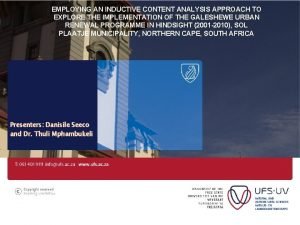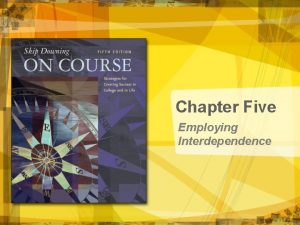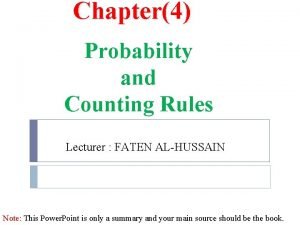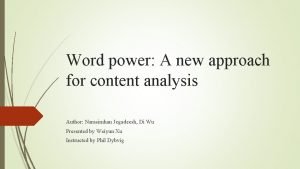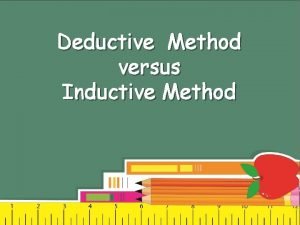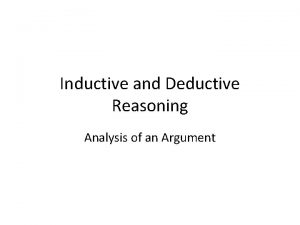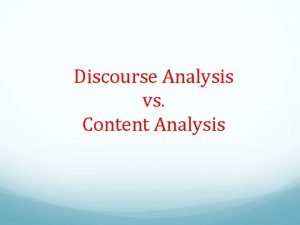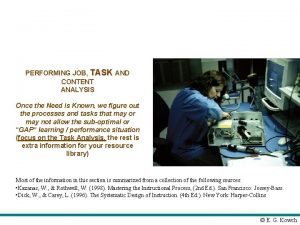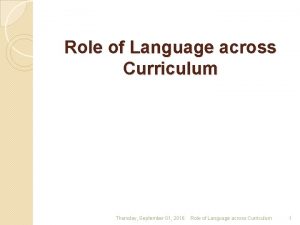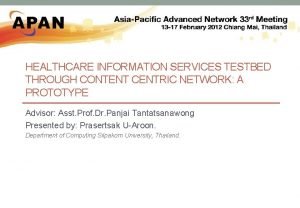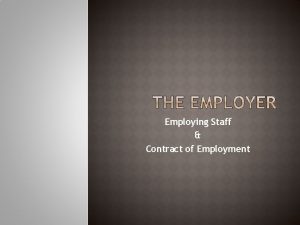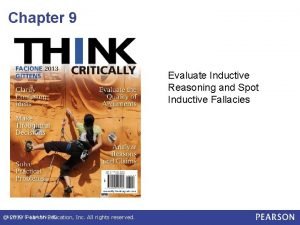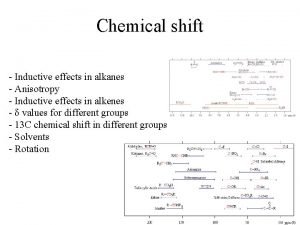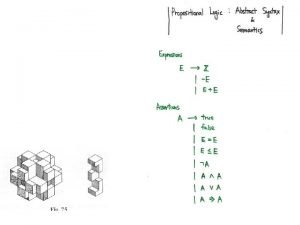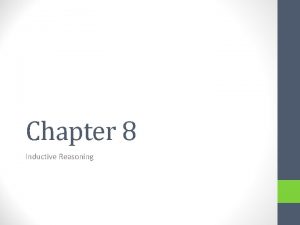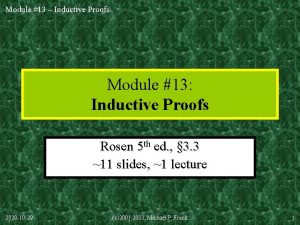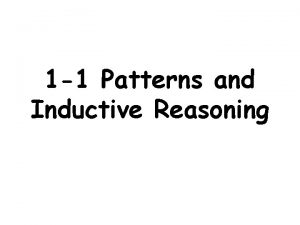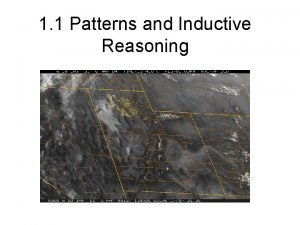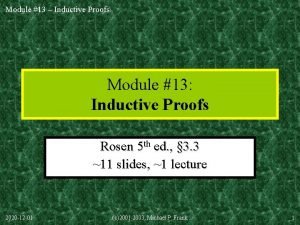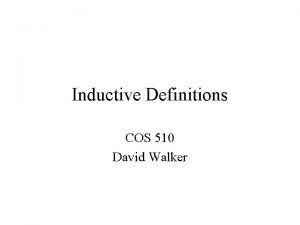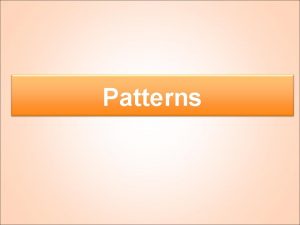EMPLOYING AN INDUCTIVE CONTENT ANALYSIS APPROACH TO EXPLORE























- Slides: 23

EMPLOYING AN INDUCTIVE CONTENT ANALYSIS APPROACH TO EXPLORE THE IMPLEMENTATION OF THE GALESHEWE URBAN RENEWAL PROGRAMME IN HINDSIGHT (2001 -2010), SOL PLAATJE MUNICIPALITY, NORTHERN CAPE, SOUTH AFRICA Presenters: Danisile Seeco and Dr. Thuli Mphambukeli

INTRODUCTION • The Urban Renewal Programme (URP) was a deliberate state intervention • On 9 February 2001 then president of South Africa, Mr Thabo Mbeki, in his state of the nation address (SONA), launched the URP • As an intergovernmental initiative to promote area-based interventions in eight urban nodes • Khayelitsha and Mitchell’s Plain in the Western Cape; Kwa. Mashu and Inanda in Kwa. Zulu-Natal; Mdantsane and Motherwell in the Eastern Cape; Alexandra in Johannesburg and Galeshewe in the Northern Cape) • To reduce urban poverty and underdevelopment (Mbeki, 2001). • To redress spatial inequalities in previously disadvantage black townships 2

Source: www. dplg. gov. za/progs/urp_publications. htm 3

PROBLEM STATEMENT • However, 11 years later, Sol Plaatje Municipality had not satisfactorily implemented the URP; • Despite a national pronouncement directed in addressing underdevelopment and spatial inequalities in previously disadvantage black townships such as Galeshewe. • Thus, the inadequate implementation of newly adopted programmes like urban renewal placed unwarranted pressure on government from a perspective of coordination and monitoring of URP related projects. • Consequently, the ramifications of the government planning under pressure (Mphambukeli, 2015: 1), dampens the preconceived ‘better life’ for all expectations within the postdemocratic state. 4

OBJECTIVE AND RESEARCH QUESTION OF THE STUDY OBJECTIVE To analyse the challenges (if any) experienced by the Sol Plaatje Municipality in setting up the Galeshewe Urban Renewal Programme. RESEARCH QUESTION What were the key issues that led to the inadequate implementation of the Galeshewe Urban Renewal Programme from 2001 to 2011? 5

METHODOLOGICAL CONSIDERATION • Employed a qualitative inductive content analysis research methodology • Content analysis is a detailed and systematic examination of the purpose of identifying themes or patterns (Leedy & Ormrod, 2001: 155) • This research adopted Elo and Kyngäs’s (2007: 110) qualitative content analysis process. • A more specific presentation of the qualitative inductive content research strategy is provided 6

Adopted from Elo & Kyngas (2007: 4) 7

HOW WE EMPLOYED THE INDUCTIVE CONTENT ANALYSIS Explanation of the systematic and structured steps 8

PREPARATION PHASE Primary Data Sources Secondary Data Sources Galeshewe Urban Renewal Programme Business Plan (GURPBP), 2004 Academic books Strategic Review Report (SRR), 2002 Academic journals and articles State of the Nation Address (SONA), 2001 – speech by President Thabo Mbeki Observation of GURP implemented projects Galeshewe Urban Renewal Newsletter National Urban Renewal Lesson Learnt document Sol Plaatje Municipality Ordinary Council Minutes (OCM) 9

ORGANISATION PHASE (OPEN CODING) Notes and headings highlighted during the review and reading of the Strategic Review Report and the Galeshewe Business Plan: • Implementation arrangements. • Funding for the programme. • Eighteen months since the announcement the development is slow. • Need to speed up development process in Galeshewe. • Socio and economic demands. • Slow pace of National Urban Renewal Programme is not due to lack of finance. • But clearer understanding among the three spheres of government is needed to advance implementation. 10

ORGANISATION PHASE (OPEN CODING CONT. ) Notes and headings highlighted during the review and reading of the Strategic Review Report and the Galeshewe Business Plan: • Declining in mining sector in Sol Plaatje Municipality. • Galeshewe and the rest of Sol Plaatje are intrinsically linked and should be recognised in the IDP. • Prime thrust of GURP is economic development should drive the urban renewal process and identified nodes should support economic growth. • Sol Plaatje is in the driving seat and the political champions are provincial government • Key institutional problems relates to cementing of intergovernmental relations. • Linkages of district municipality with URP local government structures. • Premier called a meeting which led to the hiring of consultants to develop the business plan. 11

ORGANISATION PHASE (CODING SHEET) Code Description A SRR-A 1 Implementation arrangements. SRR-A 2 Funding for the programme. SRR-A 3 Eighteen months since the announcement the development is slow. SRR-A 4 Need to speed up development process in Galeshewe. SRR-A 5 Socio and economic demands. SRR-A 6 Slow pace of National Urban Renewal Programme is not due to lack of finance. SRR-A 7 But clearer understanding among the 3 spheres of government is needed to advance implementation. B SRR-B 8 Galeshewe and the rest of Sol Plaatje are intrinsically linked and should be recognised in the IDP. SRR-B 9 Prime thrust of GURP is economic development should drive the urban renewal process and identified nodes should support economic growth. SRR-B 10 Sol Plaatje is in the driving seat and the political champions are provincial government. SRR-B 11 Key institutional problems relates to cementing of intergovernmental relations. SRR-B 12 Linkages of district Municipality with URP local government structures. 12

ORGANISATION PHASE (CODING SHEET) C SRR-C 13 Business plan and conceptual framework are key documents. SRR-C 14 Business plan comes first and the conceptual framework is focused on spatial regeneration. SRR-C 15 Conceptual development framework sees the need to develop an integrated solution that must remove constraints. SRR-C 16 Linkages of conceptual development and other frames: (1) social development, (2) Economic development and (3) Environmental improvement. SRR-C 17 Key focus of spatial strategy: (1) central circle node 1; (2) Legislative building node 2. SRR-C 18 Premier called a meeting which led to the hiring of consultants to develop the business plan. SRR-C 19 Target date for the completion of the business plan was October 2002. SR-C 20 Conceptual framework was approved on 13 August 2002. SRR-C 21 Linkage between business plans and IDP are not strong enough. SRR-C 22 The planning process is top–down with the driving force being provincial government. SRR-C 23 Community engagements started by the Sol Plaatje Municipality through ward councillors and ward committee members. SRR-D 24 Premier appoints a programme manager for special projects in August 2002. SRR-D 25 Programme manager is reports to the Head of Department of Provincial and Local Government. SRR-D 26 The Programme Managers role is manage special projects of the office of the premier, particularly URP process in Galeshewe: 1) coordination of the development process, 2) Collective synergies of major stakeholders including community, Sol Plaatje Municipality and private sector. SRR-D 27 No intension of setting up a permanent support office in DPLG. SRR-D 28 URP Organogram. SRR-D 29 Central component is URP management unit, which is to be full time Municipality staffed unit. SRR-D 30 Urban renewal manager for Sol Plaatje Municipality will be appointed in November 2002 and the unit will be staffed and operational 2002. SRR-D 31 Five task teams established (2002). SRR-D 32 Each team has a delegated official from Sol Plaatje Municipality to lead the process. SRR-D 33 Co-ordination between the province and the Municipality has been inadequate and province is the driving force of GURP. SRR-D 34 Different roles and responsibilities of three spheres of government. *Provincial Government to co-ordinate the development process *Sol Plaatje Municipality to lead the Implementation SRR-D 35 A draft memorandum of understanding is drafted outlining the different roles and responsibilities. D 13

GROUPING AND FAMILIES Sub-category Implementation Arrangements. The role of three spheres of government – National, Provincial and Local RE-GURP Business Plan and Conceptual framework Organisational Arrangements Code Notes and Headings SRR-A 3 18 months after the announcement progress in initiating the development process is slow. SRR-C 18 Premier called a meeting which led to the hiring of consultants to develop a business plan for GURP. SRR-C 22 The planning process is top-down the driving force being provincial government. SRR-D 28 URP Organogram SRR-A 6 Slow pace of National Urban Renewal Program is not due to lack of funding but a need for clearer understanding among 3 spheres of government to advance implementation. SRR-B 11 Key institutional problems for Galeshewe Urban Renewal relates to cementing of intergovernmental relations. SRR-B 12 Linkages of District Municipality with GURP playing coordinating role unlikely to have a significant direct involvement. SRR-D 33 Coordination between the province and the Municipality has been inadequate and province has been driving GURP. SRR-D 34 Sol Plaatje Municipality reacted in rectifying the role confusion and all parties agreed to sign a Memorandum of Understanding of the different roles and responsibility that each spheres must undertake. Province seen as the coordinating the development process. Sol Plaatje Municipality leading the Implementation process. SRR-C 15 Conceptual development framework sees a need for an integrated solution that must remove constraints to development. SRR-C 19 Targeted dates for the completion date for the GURP Business plan October 2002. SRR-C 20 Conceptual framework was approved 13 August 2002. SRR-C 21 Linkage between the Integrated Development Plan of Sol Plaatje Municipality and the URP Business plans are weak. SRR-C 23 Community is engagement is started by the Municipality through ward councillors and ward committee members. SRR-D 24 Premier a programme manager for special projects in August 2002. SRR-D 25 Programme manager reports to the Head of Department of provincial local government. SRR-D 26 Role of the Programme Manager is to manage special projects in the office of the premier, particularly the GURP process. SRR-D 27 No intension to setting up a permanent URP supporting office at DPLG. SRR-D 29 Central component of the URP management unit, which is to be a full- time Sol Plaatje Municipality staffed unit devoted exclusively to Urban Renewal Programme. SRR-D 30 Urban renewal manager will be appointed in November 2002 and the unit will be staffed and operational in November 2002. SRR-D 31 Five Task teams established in 2002: Infrastructure Technical Committee. Spatial Planning Technical Committee. Social Development and Environmental Task team. Local Economic Development Task team. Safety and Security Task team. SRR- D 32 Each team has a delegated official from Sol Plaatje Municipality to lead the process. 14

ABSTRACTION AND MAPPING OF CATEGORIES 15

16

17

BEFORE AFTER 18

BEFORE AFTER 19

FINDINGS (DEFENSIBLE INFERENCES) • Defensible Inference 1: Contextualising and politicising GURP in hindsight from 2001 to 2010 • Defensible Inferences 2: Political and socio-economic disconnect of the Galeshewe Urban Renewal Programme 20

Defensible Inference 1: Contextualising and politicising GURP in hindsight from 2001 to 2010 Issues Institutional setting Slum / informal settlement upgrading Western Countries Global South Initially URP was housed by property developers and business owners in the inner cities such as Baltimore and Landon. In South Africa the URP was introduced by the national government and the implementation was left to provinces and local government. At a later stage, due to unrest and confrontation between black communities, the federal state intervened through the Housing Act of 1949. Nationally, DPLG was the ministry that championed the programme. It approached URP from an intergovernmental premise. The idea of upgrading in the USA and Britain was removal of low-income groups, mostly black, to the outskirts of the inner-city. The peripheral development trend of low-income groups in South Africa is similar to that of the West, even though post-1994 integration was the buzzword in planning circles. Slum clearance was done to attract the middle- and upper-class to the inner city and slums were seen as chasing away investors. A classic example is the forceful removal of the inhabitants of Bertrams leading to the 2010 Soccer World Cup in Johannesburg. Local economic development The URP in the USA and Britain did not prioritise the equal distribution and development of the local economy; instead there was a monopoly capital between property developers and real estate business. LED in South Africa was one of the pillars in which URP was conceptualised. The EThekwini Metropolitan used URP to transform trading space in the Warwick Avenue area by creating conducive spaces for informal traders. Skills development and training In Birmingham in England training was the focal point of the upgrading and rehabilitation projects and emphasis was placed on job training. South Africa through the urban renewal projects and Extended Public Works Programme (EPWP), trained people on job to transfer skills to develop an employable base similar to that of Birmingham in the England. Socio-political implications In the USA, URP was a political programme that lobbied monopoly capital class in a form of businessmen and property developers. The implication of the URP in the USA was that people were forcefully removed through the enactment of the Housing policy Act of 1949. The research has already located the urban realities that characterised apartheid planning. In South Africa, segregative planning was a political move to exclude black townships in the voting system and provision of services. Post-1994 URP was used by the ANC government as a political planning programme which ought to respond to social ills created by apartheid. Public Participation The urban poor in the inner city of Baltimore in the USA did not participate in the renewal process, but were regarded as an interest group. The big role players were property developers and business people in the inner city of Baltimore. Those involved in participation in developed countries were merely the interest groups in inner-city development. Compared to the USA, South Africa’s implementation of URP had a proper public participation mechanism. The implementation of URP in South Africa was implemented through local government and was part of the Integrated Development Plan (IDP) in which communities participated before it was approved. 21

DEFENSIBLE INFERENCES 2: POLITICAL AND SOCIO-ECONOMIC DISCONNECT OF THE GALESHEWE URBAN RENEWAL PROGRAMME 22

CONCLUSIONS Why would the community of Galeshewe not value and take ownership of assets that are meant to improve and uplift their community or lives? • • The URP was a top-down initiative that perceived to have understood the needs of communities such as that of Galeshewe, but in essence did not understand what was happening on the ground which produces a disconnect of real needs of communities, but fulfilled those of politicians. The assumption in creating LED projects such as the No. 5 Taxi Rank and Mayibuye Upraising Square was that if government built LED facilities, it will stimulate the entrepreneurship in Galeshewe, but that was not the case. 23
 Inductive content analysis
Inductive content analysis Is employing tricks to add some magic to the presentation
Is employing tricks to add some magic to the presentation Employing interdependence
Employing interdependence When employing the fundamental counting rule
When employing the fundamental counting rule Word power: a new approach for content analysis
Word power: a new approach for content analysis Inductive learning approach
Inductive learning approach Inductive method of teaching
Inductive method of teaching Inductive and analytical learning in machine learning
Inductive and analytical learning in machine learning What is inductive method
What is inductive method Inductive reasoning examples
Inductive reasoning examples Induction meaning in logic
Induction meaning in logic Characteristics of esp
Characteristics of esp Static content vs dynamic content
Static content vs dynamic content Content meaning
Content meaning Task analysis and content analysis
Task analysis and content analysis Content analysis secondary data
Content analysis secondary data Role of language across curriculum
Role of language across curriculum Content centric approach
Content centric approach Difference between datagram and virtual circuit switching
Difference between datagram and virtual circuit switching Cognitive approach vs behavioral approach
Cognitive approach vs behavioral approach Shower approach
Shower approach Multiple approach-avoidance
Multiple approach-avoidance Cognitive approach vs behavioral approach
Cognitive approach vs behavioral approach Research design definition
Research design definition
